|
|
| |
|
 | Search: |
|
|
|
|
|
 |
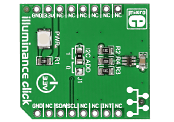
|
|
Illuminance click carries a TSL2561 light-to-digital converter with a sensor that's designed to mimic the way humans perceive light. This makes it ideal for applications where ambient lighting conditions have to be measured (backlight power-saving on LCD displays for example). The sensor has two photodiodes. One sensitive to full-spectrum light, the other to infrared. The visible-spectrum is then deduced by using a formula. Illuminance click communicates with the target board through mikroBUS I2C lines, and uses a 3.3V power supply. |
|
|
|
|
 |
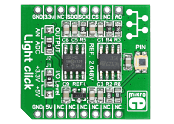
|
|
Light Click is the add-on board which features the PD15-22CTR8 PIN photodiode, providing an effective and easy way to measure ambient light intensity. It also features the MAX6106 voltage reference and MCP3201 ADC with SPI interface. Measured ambient light intensity is sent as an analog or digital signal to the main board microcontroller. Light Click communicates through mikroBUS SPI (MISO, SCK, CS) and AN lines. The PD15-22C-TR8 is a high photosensitive light sensor with fast response time. An SMD jumper allows the user to select whether the board will be powered with a 3.3V or 5V power supply. |
|
|
|
 |
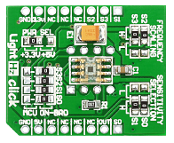
|
|
LightHz Click is an accessory board in the mikroBus form factor. The board features the TSL230BR programmable light-to-frequency converter. The output can be either a pulse train or a square wave (50% duty cycle), with frequency directly proportional to light intensity. Device sensitivity is selectable in three ranges, providing two decades of adjustment. The full-scale output frequency can be scaled by one of four preset values. The board features a voltage selection SMD jumper which determines whether it will operate on 5V or 3.3V. |
|
|
|
 |
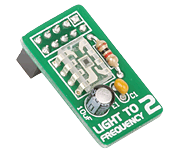
|
|
The Light to Frequency 2 Board enables you to connect your development board to a light-to-frequency converter. The board features a programmable light-to-frequency converter TSL230BR and is connected to a prototype device via an IDC10 connector. |
|
|
|
 |
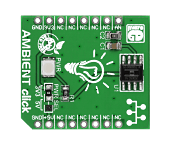
|
|
Ambient click carries the Melexis MLX75305 IC. It's a CMOS integrated optical sensor that consists of a photodiode, a transimpendance amplifier, and an output transistor. The chip converts ambient light intensity into a voltage, using the mikroBUS AN pin for communicating with the target board MCU. The board is designed to use either a 3.3V or a 5V power supply. |
|
|
|
 |
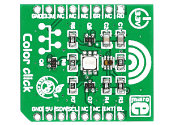
|
|
Color click is a compact and easy solution for adding color sensing to your design. It features a TCS3471 color light sensor as well as an RGB LED diode. The TCS3471 features red, green, blue, and clear light sensing (RGBC) that detects light intensity under a variety of lighting conditions and through a variety of attenuation materials. An RGB LED is provided to help you illuminate the objects if no other light source is available. Color click communicates with the target board microcontroller via mikroBUS I2C (SDA, SCL) and INT lines. The board is designed to use 3.3V power supply only. |
|
|
|
 |
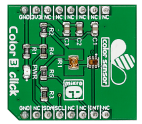
|
|
Color 3 click is a mikroBUS add-on board with a TCS3771 color sensor (also known as a light-to-digital converter) and a narrow beam Infrared LED. The circuit can also function as a proximity sensor.
TCS3771 is a RGBC sensor: it can detect Red, Green, Blue and clear light. The IC performs well under a variety of lighting conditions. For example, it can be covered with different attenuation materials.
As a proximity sensor it has a large dynamic range of operation. It can take short distance measurements behind dark glass; or it can be configured for longer distance measurement, for example, human presence detection in front of monitors or laptops.
For power-saving, TCS3771 has an internal state machine that can put the device into a low power mode between successive RGBC and proximity measurements.
TCS3771 is also fast enough to give off proximity information at a high rate of repetition. This makes it useful for proximity detection in portable devices (such as a phone coming near to a speaker’s ear).
Color 3 click communicates with the target MCU through the mikroBUS I2C interface, with additional functionality provided by an INT pin. Designed to use a 3.3 power supply only. |
|
|
|
 |
|
|

